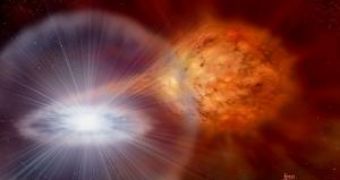Ophiucus is a large constellation 5,000 light years from Earth, located in the southern hemisphere near the center of the Milky Way, between Scorpio to the west and Sagittarius to the east. Of the 13 zodiacal constellations (which contain the Sun during the course of the year), Ophiuchus is the only one not counted as an astrological sign.
Ophiuchus is depicted as a man supporting a serpent; the interposition of his body divides the snake into two parts, Serpens Caput (head) and Serpens Cauda (tail), which are nonetheless counted as one constellation. It consists of a white dwarf, a super-dense dead star about the size of the Earth which was once the core of a star, like the Sun and whose outer layers have been lost into space in close orbit with a much larger, so-called red giant star.
A recent titanic explosion took place in this star system and Hubble space telescope has the pictures to prove it.
Professor Michael Bode of Liverpool John Moores University described how these unique observations shed new light on the circumstances of such events.
12 February 2006 - Japanese amateur astronomers reported that a star in the constellation of Ophiuchus (known as RS Oph for short) had suddenly brightened and become visible even with the unaided eye in the night sky. Although this was the latest in a series of such outbursts of this star that have been spotted over the last hundred years or so, it was the first one since 1985 and gave scientists an opportunity to study it with new, more powerful, telescopes on the ground and in space.
The white dwarf and the red giant are so close together that the strong gravitational field of the former continuously pulls hydrogen-rich gas from the outer layers of the latter. After around 20 years, so much gas builds up that a runaway thermonuclear explosion occurs on the white dwarf's surface. In less than a day, its energy output increases to over 100,000 times that of the Sun and a quantity of gas equivalent to the mass of the Earth is ejected into space at speeds of several thousands of kilometers per second (several million miles per hour).
Explosions such as this on short timescales of decades can only be explained if the white dwarf is near the maximum mass it could have without having collapsed to become an even denser object - a neutron star during a supernova explosion.
The fact that the red giant is losing enormous amounts of gas in a wind that envelops the whole system results in an explosion on the white dwarf occurring effectively inside its companion's atmosphere and the ejected gas then slamming into it at very high speed.
Optical observations with the orbiting Hubble Space Telescope (HST) were made in July 2006, in order to determine more precisely what was happening.
Dr Dan Harman of Liverpool JMU took on the task of analyzing the resulting data. "The problem here was that, seen from a distance of 5,000 light years, we were looking for what would appear to be very tiny and very faint features buried within the glare from the bright central star a bit like trying to read the registration (license) plate of an approaching car with its headlights on at night. However, after carefully removing the confusing effects of the star we were astounded by the results".
The team was thus able to explain that what we may be seeing is emission from the boundary of a rapidly expanding region shaped something like a peanut, but inclined towards us at an angle of around 40 degrees. The central stars orbit around each other in the plane of the region and the rings we see are a natural consequence of us looking through this inclined structure.

 14 DAY TRIAL //
14 DAY TRIAL //